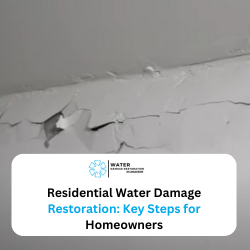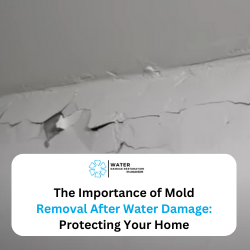Water damage in your home can be overwhelming. Whether caused by a burst pipe, storm, or flood, the aftermath requires immediate action to prevent further destruction and health risks. For Anaheim residents, understanding the process of residential water damage restoration Anaheim is essential to protect your property and family.
This guide covers the key steps homeowners should take, the importance of professional services, and how to address related challenges, such as flood damage restoration Anaheim.
Why Quick Action is Critical
Consequences of Water Damage
Water damage doesn’t just ruin belongings; it compromises your home’s structural integrity and can lead to:
- Mold Growth: Mold thrives within 24-48 hours of water exposure.
- Structural Issues: Prolonged water saturation weakens walls, floors, and foundations.
- Health Risks: Contaminated water can carry bacteria, posing health hazards.
Immediate action minimizes the damage and ensures a faster recovery.
Step-by-Step Residential Water Damage Restoration Anaheim
Step 1: Ensure Safety First
Before addressing the damage, make safety your top priority.
- Turn Off Utilities: Shut off electricity and gas to avoid hazards.
- Avoid Contaminated Water: Floodwater can carry sewage and chemicals.
- Protect Yourself: Use gloves, boots, and masks when entering affected areas.
Step 2: Assess the Damage
Document the extent of the water damage for insurance purposes.
- Take Photos: Capture images of damaged walls, flooring, and belongings.
- List Affected Items: Create an inventory of destroyed or damaged property.
- Call Your Insurance Provider: Begin the claims process as soon as possible.
Step 3: Remove Standing Water
Water extraction is critical to prevent further damage.
- DIY Methods: Use mops, buckets, and wet/dry vacuums for small amounts of water.
- Professional Services: For severe flooding, hire experts in residential water damage restoration Anaheim who use industrial pumps and vacuums.
Step 4: Dry and Dehumidify
After removing standing water, it’s essential to dry your home thoroughly.
- Air Circulation: Use fans to speed up the drying process.
- Dehumidifiers: Remove moisture from the air to prevent mold growth.
- Inspect Hidden Areas: Ensure walls, ceilings, and under flooring are completely dry.
Step 5: Clean and Disinfect
Floodwaters often carry contaminants that require thorough cleaning.
- Disinfect Surfaces: Use antimicrobial solutions to sanitize walls, floors, and furniture.
- Dispose of Damaged Items: Safely discard porous materials like carpets and drywall if they are unsalvageable.
- Protect Your Health: Wear protective gear during cleaning to avoid exposure to harmful bacteria.
Step 6: Restore and Repair
Once the water is gone and the area is clean, focus on restoring your home.
- Replace Damaged Materials: Install new drywall, flooring, and insulation as needed.
- Repair Structural Issues: Address weakened foundations or compromised support beams.
- Consider Upgrades: Use this opportunity to install water-resistant materials or improve drainage systems.
The Role of Professionals in Residential Water Damage Restoration Anaheim
Expertise and Efficiency
While DIY efforts can mitigate minor damage, professionals offer:
- Advanced Equipment: Industrial-grade tools for water extraction, drying, and dehumidification.
- Comprehensive Solutions: From flood damage restoration Anaheim to mold prevention, experts address all aspects of water damage.
- Faster Recovery: Skilled technicians work quickly to restore your home and minimize downtime.
Preventing Future Water Damage
Regular Maintenance
- Inspect Plumbing: Check for leaks or corrosion in pipes and fixtures.
- Maintain Gutters and Drains: Ensure water flows away from your home’s foundation.
- Seal Cracks: Use waterproof sealant on walls, windows, and foundations.
Emergency Preparedness
- Install a Sump Pump: Protect your basement from flooding.
- Water Sensors: Detect leaks early and prevent extensive damage.
- Have a Plan: Keep contact information for local residential water damage restoration Anaheim specialists on hand.
The Importance of Mold Prevention
Why Mold Removal Matters
Mold is a common aftermath of water damage, and ignoring it can lead to:
- Health Risks: Mold exposure causes allergies, respiratory issues, and other illnesses.
- Property Damage: Mold weakens structures and spreads rapidly.
How Professionals Help
Experts specializing in flood damage restoration Anaheim often include mold remediation in their services. They:
- Identify Hidden Mold: Use advanced tools to locate mold in unseen areas.
- Remove Mold Safely: Contain and eliminate spores using specialized techniques.
- Prevent Future Growth: Apply treatments to inhibit mold development.
Choosing the Right Restoration Partner
When selecting a provider for residential water damage restoration Anaheim, look for:
- Certifications and Experience: Ensure they’re IICRC-certified and have a proven track record.
- Local Expertise: Anaheim professionals understand the area’s unique climate and water damage risks.
- Comprehensive Services: Opt for companies that handle both water and mold damage, ensuring thorough restoration.
Final Thoughts
Water damage can be stressful, but with the right knowledge and quick action, you can minimize its impact. Following these steps for residential water damage restoration Anaheim ensures a safer, faster recovery.
For Anaheim homeowners, partnering with professionals skilled in flood damage restoration Anaheim and mold remediation provides peace of mind and expert care. Don’t wait—act swiftly to restore your home and protect your loved ones.



